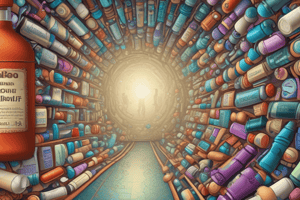Podcast
Questions and Answers
What is the primary metabolic effect of NE on blood sugar concentrations?
What is the primary metabolic effect of NE on blood sugar concentrations?
Which receptor activation leads to glycogenolysis by NE?
Which receptor activation leads to glycogenolysis by NE?
Why does NE increase blood pressure more than Epinephrine at similar doses?
Why does NE increase blood pressure more than Epinephrine at similar doses?
At similar doses, which catecholamine is more likely to elicit baroreceptor reflex at lower doses?
At similar doses, which catecholamine is more likely to elicit baroreceptor reflex at lower doses?
Signup and view all the answers
In which situation is Epinephrine commonly used therapeutically?
In which situation is Epinephrine commonly used therapeutically?
Signup and view all the answers
What is one of the specific therapeutic uses of Epinephrine mentioned in the text?
What is one of the specific therapeutic uses of Epinephrine mentioned in the text?
Signup and view all the answers
Which medication may be administered topically to control localized hemorrhage?
Which medication may be administered topically to control localized hemorrhage?
Signup and view all the answers
For what condition can Norepinephrine be used therapeutically?
For what condition can Norepinephrine be used therapeutically?
Signup and view all the answers
Which of these medications is NOT primarily used for treating severe hypersensitivity reactions?
Which of these medications is NOT primarily used for treating severe hypersensitivity reactions?
Signup and view all the answers
Which receptor type is responsible for eliciting most of the pharmacological effects of Norepinephrine?
Which receptor type is responsible for eliciting most of the pharmacological effects of Norepinephrine?
Signup and view all the answers
What effect does Epinephrine have on cutaneous blood flow?
What effect does Epinephrine have on cutaneous blood flow?
Signup and view all the answers
Study Notes
Mechanism of Action of Catecholamines
- Catecholamines are ineffective in correcting hypotension in most types of shock due to high sympathetic activity.
- Norepinephrine (NE) is used for acute hypotension (e.g., sepsis) and cardiac arrest.
- Dopamine boosts cAMP in low doses, leading to renal vasodilation and increased blood perfusion; at higher doses, it causes general vasoconstriction.
- Dopamine receptors include D1 (associated with vasodilation) and D2 (inhibits neurosecretion).
Therapeutic Uses of Dopamine
- Therapeutic applications are specifically for septic shock, cardiogenic shock, and acute heart failure.
- Dopamine is contraindicated in chronic heart failure.
Adverse Effects of Catecholamines
- Epinephrine can cause anxiety, palpitations, cerebral hemorrhage, and cardiac arrhythmias by increasing myocardial oxygen demand.
- Norepinephrine can lead to tissue necrosis from extravasation due to vasoconstrictive effects.
- Dopamine can cause similar effects but are typically short-lived due to rapid metabolism.
Pharmacological Effects of Isoproterenol
- Isoproterenol infusion reduces blood pressure via β2 receptor vasodilation while increasing cardiac output through β1 receptor activation.
- Administered parenterally or as an aerosol for acute bronchial constriction and complete A-V block.
- Adverse effects include tachycardia and arrhythmias.
Phenylephrine Overview
- Phenylephrine, an α1 agonist, primarily increases blood pressure through vasoconstriction.
- Administered via various routes; useful as a vasopressor when cardiac stimulation is undesirable.
- Adverse effects include bradycardia and hypertension.
Dobutamine Characteristics
- A racemic mixture primarily activating β1 receptors, leading to increased cardiac output due to enhanced contractility.
- Utilized in short-term treatment of heart failure through IV infusion, with rapid onset and short half-life.
- Caution required to avoid increased myocardial oxygen demand post-myocardial infarction.
Ephedrine's Mechanism of Action
- Ephedrine acts as a mixed-acting agent, promoting norepinephrine release and activating adrenergic receptors.
- Effects include vasoconstriction, cardiac stimulation, and bronchodilation.
- Commonly used for asthma and urinary incontinence treatment; cautious due to potential side effects like hypertension and CNS stimulation.
Phenylpropanolamine (PPA)
- Similar to ephedrine but with less CNS stimulation; used primarily to control urinary incontinence.
- Has a longer duration of action, but potential risks like hemorrhagic stroke led to its market withdrawal in some regions.
Terbutaline's Role
- A selective β2 agonist preferred for bronchodilation in patients with heart disease.
- Administered through parenteral or oral routes; effective in treating bronchospasms with minimal systemic effects.
General Notes on Catecholamines
- Primary metabolism occurs through COMT and MAO, leading to rapid inactivation and elimination in urine.
- Catecholamines are not effective via oral administration due to metabolism by the liver and kidneys, which express high levels of MAO and COMT.
Adrenergic Receptors and Side Effects
- Long-term use of β-receptor antagonists may lead to upregulation of receptors, causing rebound effects upon withdrawal.
- Adverse effects across various catecholamines typically include cardiovascular fluctuations and CNS overstimulation.
Studying That Suits You
Use AI to generate personalized quizzes and flashcards to suit your learning preferences.
Description
Test your knowledge on the pharmacology of norepinephrine and dopamine, focusing on their effects on different vascular beds and circulation in conditions like sepsis and cardiac arrest. Explore the mechanisms of action and differences in renal effects between the two drugs.




